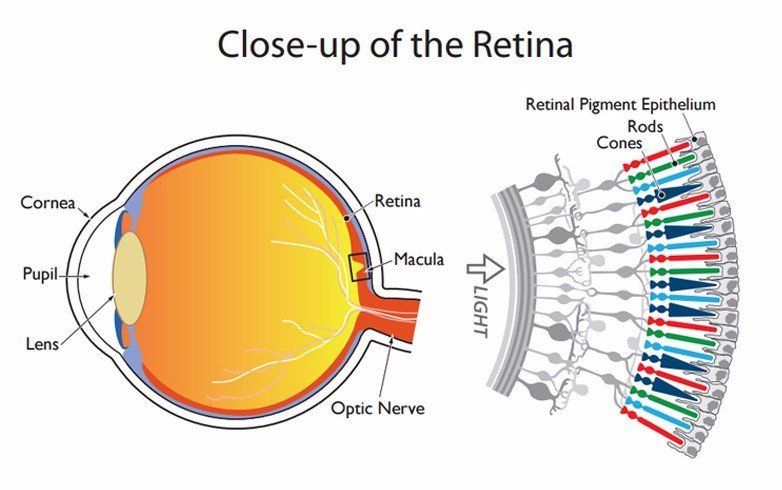Could I Be Color Blind?
What Does Being Color Blind Really Mean?
Do your friends often comment on your ‘unique’ choices when it comes to matching colors and patterns? Being fashionably challenged might not be entirely your fault (or it could be). You might be having an extra difficult time due to color blindness.
Color blindness is actually somewhat of a misuse of the word as those affected by the condition can actually still see color - just with a more limited palette. Color vision deficiency is actually the more accurate term. However, there is a rare form of color vision deficiency known as achromatopsia where you are in fact completely devoid of color in your world- but we’ll get to that one a little later. For now, let’s start with the basics.
Rods & Cones
Inside of our eyes we have photoreceptors called rods and cones. The rods are responsible for helping us to see in low lighting conditions and the cones are responsible for our color vision. In ‘color blindness’, there is a difference or deficiency in how one or more of these light-sensitive cones responds to certain wavelengths of light. This causes different levels of difficulty distinguishing between varying shades of the same color, differences between similar or opposing colors, and even the absence of a specific color altogether.
Color vision deficiency is usually inherited and present at birth. However, in some cases color blindness can be acquired. The severity of the symptoms of acquired color blindness will usually vary over time depending on the cause. Certain chronic illnesses, accidents or head trauma, medications, industrial or environmental chemical exposure can all lead to color vision deficiency.
If you notice a change in your perception of color please contact your eyecare professional immediately.
Color blindness isn’t a one size fits all category, either. There are actually several kinds of color vision deficiencies that fall into 1 of 3 main categories.
Anomalous Trichromacy
In Anomalous Trichromacy the cones are able to perceive all wavelengths of light. However, the sensitivity to one of these wavelengths is weakened causing a different effect depending on which wavelength is involved and can range from close to normal to an almost complete absence of the ‘faulty’ color.
For example:
Protanomaly - a reduced sensitivity to red light
Deuteranomaly - a reduced sensitivity to green light (also the most common form)
Tritanomaly - a reduced sensitivity to blue light (rare)
Those who experience deuteranomaly and protanomaly are what people refer to as red-green colorblind and will typically struggle to distinguish between reds, greens, browns, and oranges as well as confusing different shades of blues and purples.
Tritanomaly, however, makes it difficult to identify differences between blue and yellow, violet and red, and blue and green. In these rarer cases, the world appears as varying shades of red, pink, black, white, grey, and turquoise.
Dichromacy
Unlike anomalous trichromacy that has weakened color perceptive cones, Dichromacy is the result of one type of color receptor being absent completely, causing a total inability to see specific colors. Furthermore, individuals affected by dichromacy notice no improvement in their ability to perceive certain colors, whereas about half of those affected by anomalous trichromacy will notice their ability actually improves in good lighting.
Protanopia - inability to perceive colors on the red spectrum of visible light
Deuteranopia - inability to perceive colors on the green spectrum of visible light
Tritanopia - inability to perceive colors on the blue spectrum of visible light
Monochromacy
Finally there is monochromacy or achromatopsia. This is true color blindness, as the cone cells are either absent completely or non-functional. Achromatopsia is incredibly rare and only occurs in approximately 1 in every 33,000 individuals. Monochromats have no color at all in their world and instead see shades of grey varying from black to white.
Those with achromatopsia will usually also have some other symptoms like nystagmus (a condition that causes the eyes to make repetitive, uncontrolled movements) and extreme light sensitivity.
Signs In Children
By the time we are adults, most of us will have an idea of whether or not we might be colorblind. However, it can be harder for children to express difficulties, and in most cases they may not be aware that what they are seeing is different from what everyone else sees. Here are some symptoms of color vision deficiency you can look out for :
- Using the wrong colors for an object when coloring (keep in mind this could just be artistic expression - so be sure to ask your child why they chose that particular color)
- Complaints of eye or head hurting if looking at something red on a green background or vice versa
- Low attention span when coloring
- Identification of colors seeming worse in low light conditions, small areas of color, and with colors of the same hue
- Difficulty distinguishing colors or making mistakes when identifying colors
- Smelling food before eating
- Sensitivity to bright lights
- Problems identifying red or green crayons, colored pencils, or any other color with red or green in its composition such as purple or brown
- Trouble reading worksheets with colored pages or with color on color composition
- Exceptional night vision
If you suspect you or your child might be color blind - schedule a visit to your eye care provider for a comprehensive eye exam and make sure to request that they check your color vision. In the meantime, you can also visit Enchroma for a free color vision screener. Just keep in mind that only an eye care professional can give you a true medical diagnosis of color blindness.







